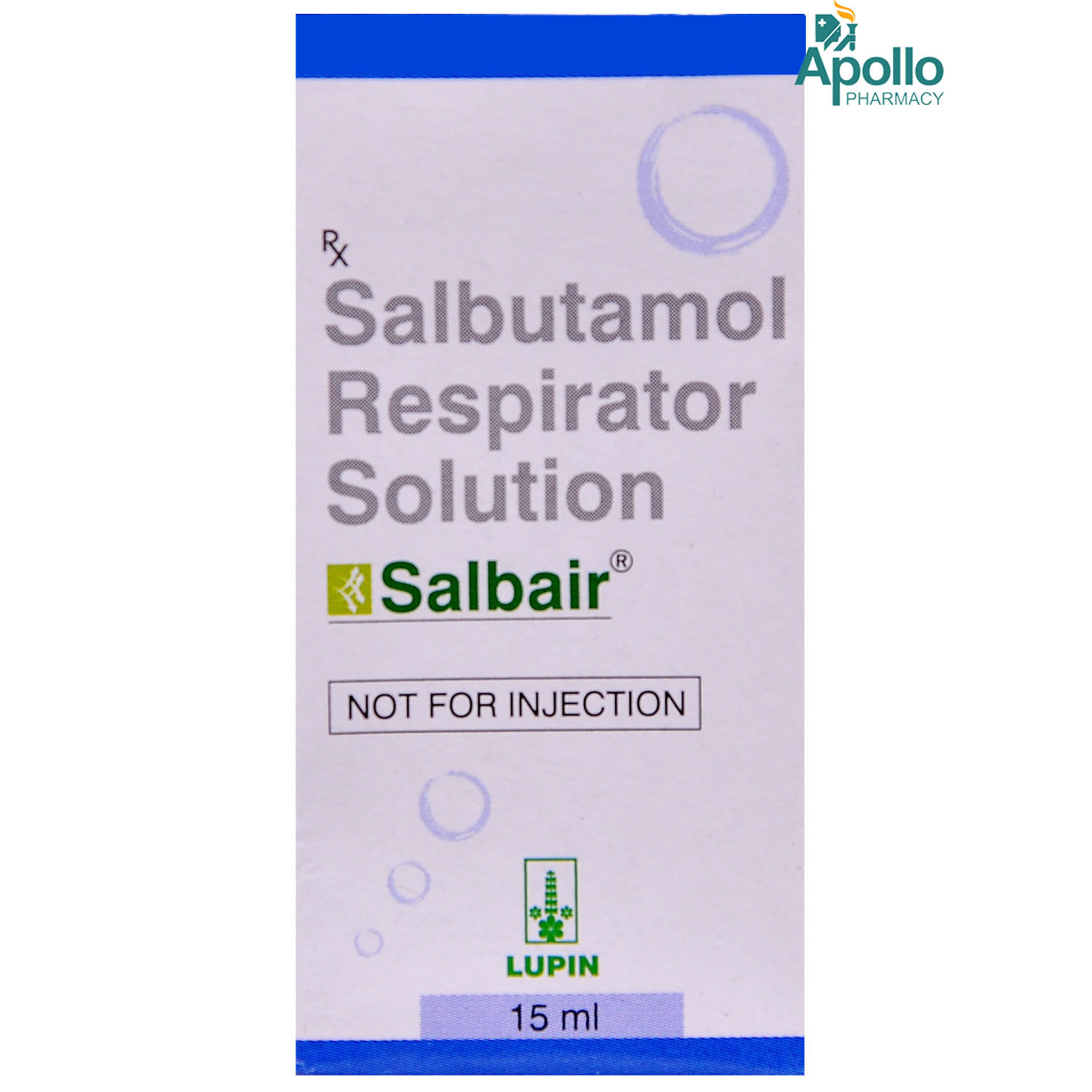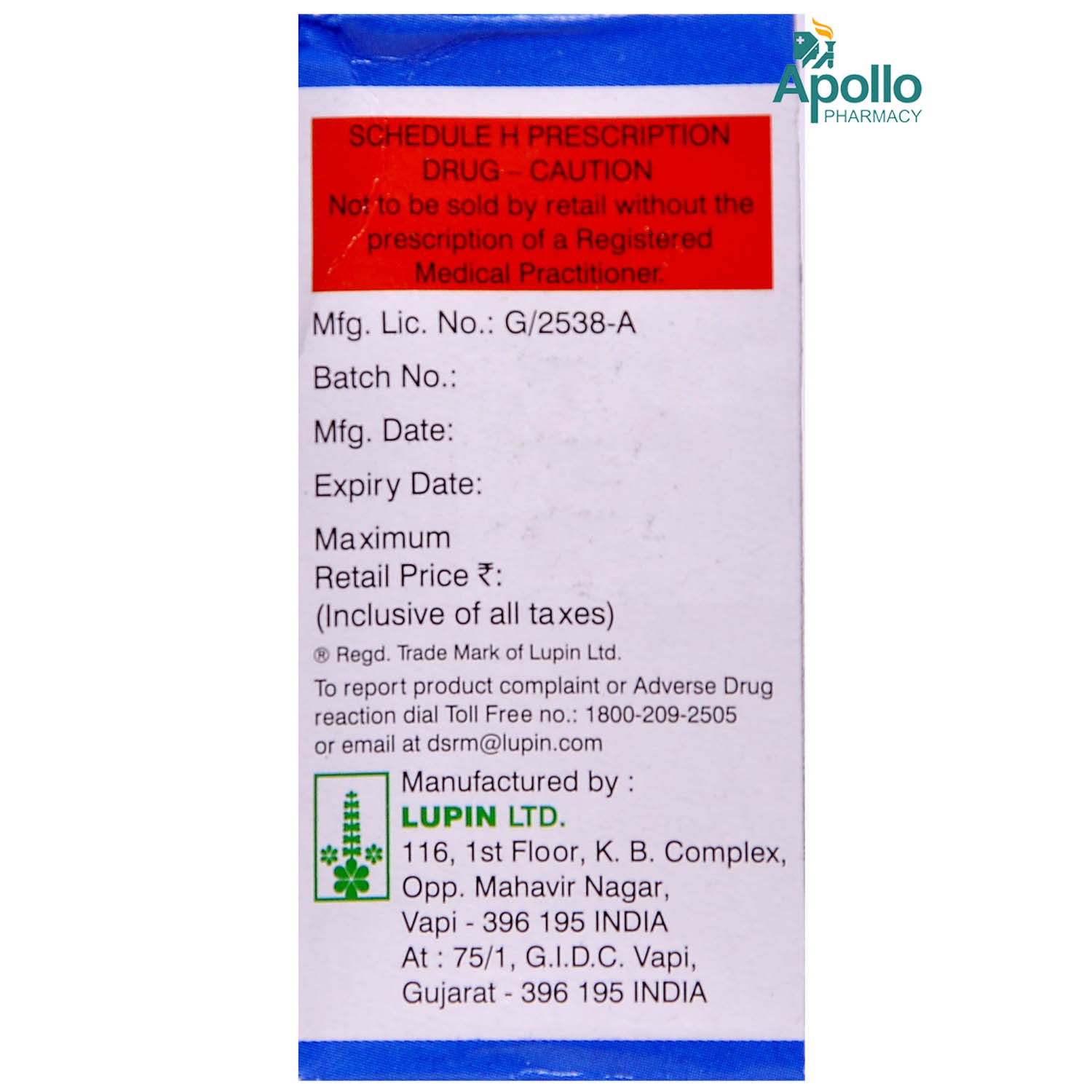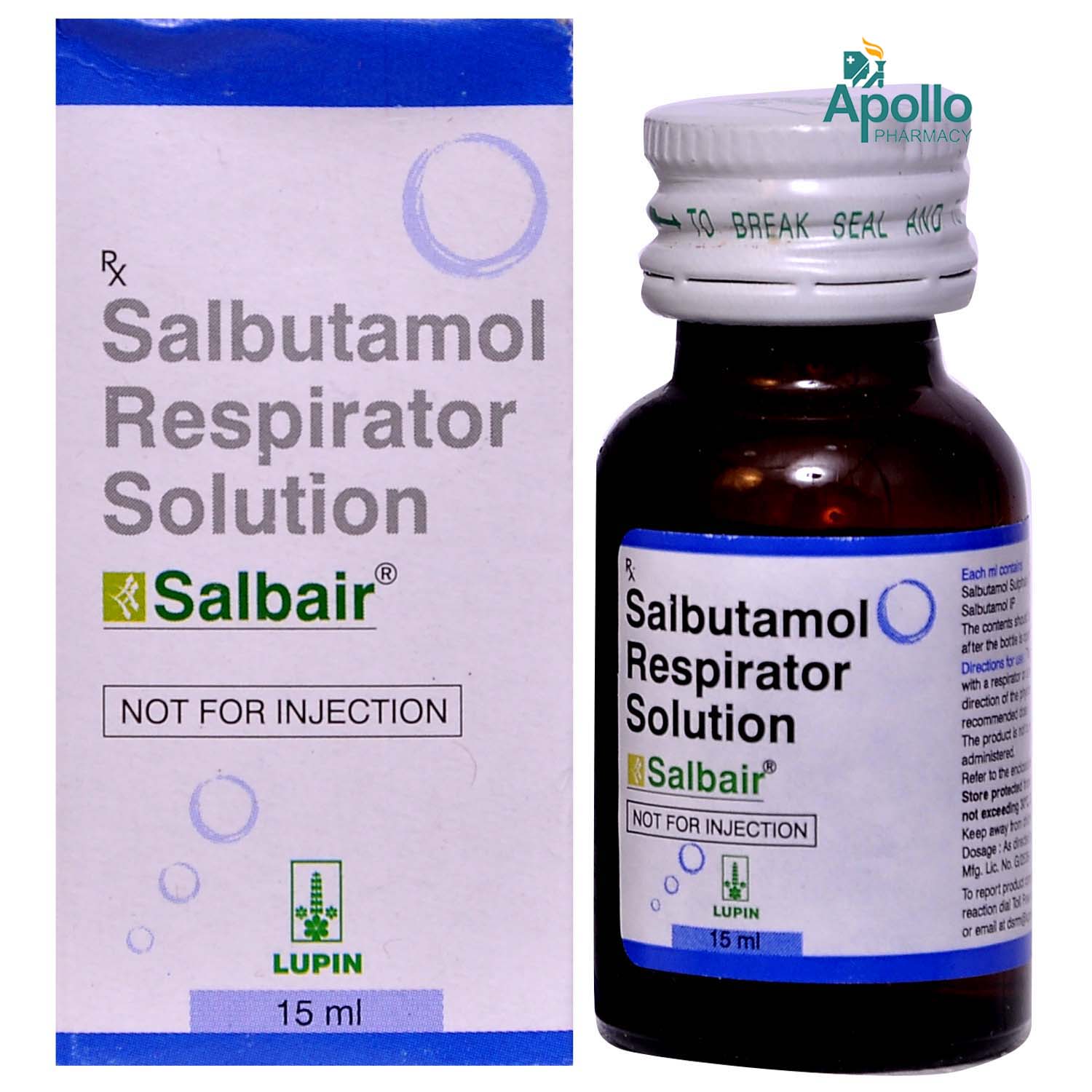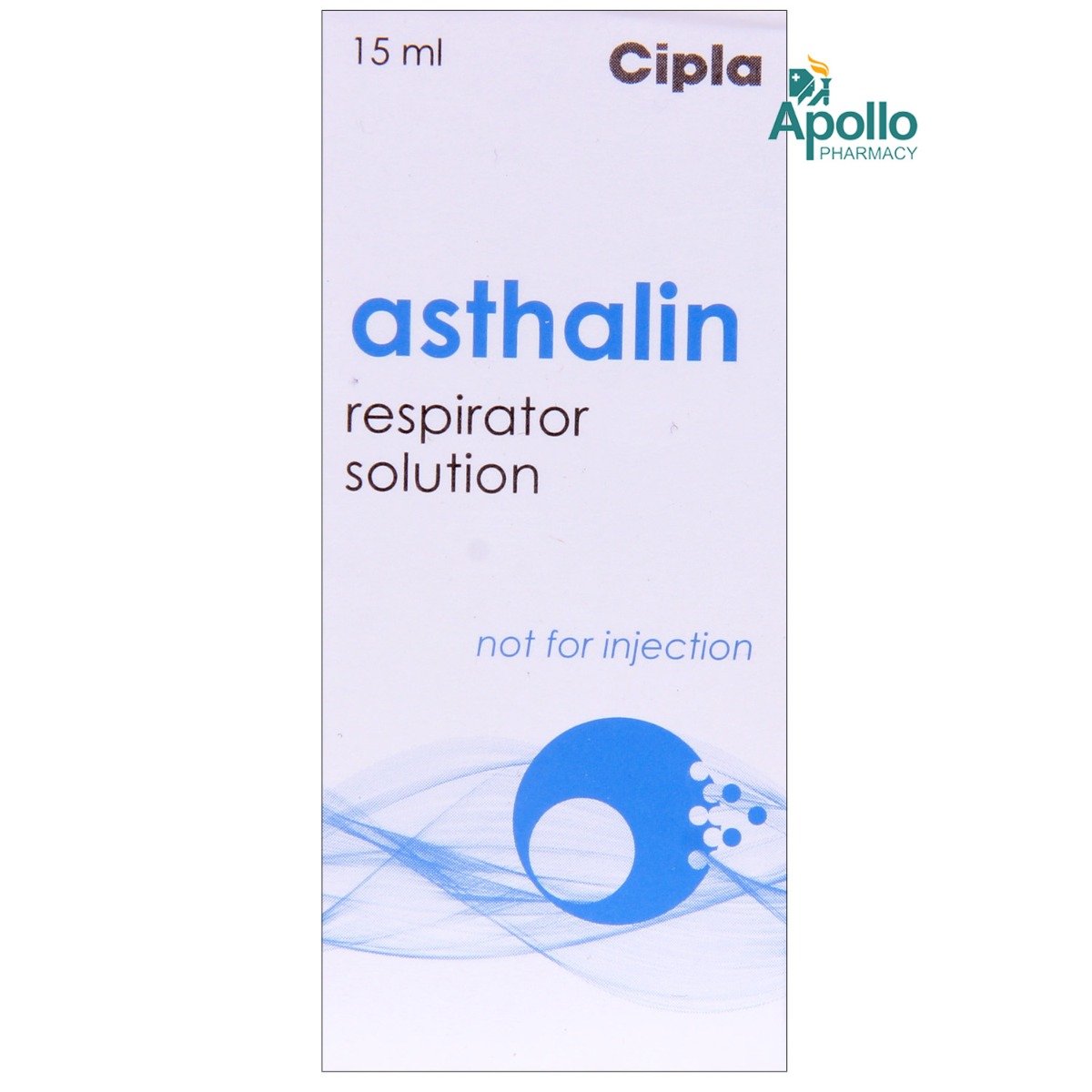SALBAIR RESPIRATORY SOLUTION






MRP ₹8.5
(Inclusive of all Taxes)
₹1.3 Cashback (15%)
Provide Delivery Location
Online payment accepted
 Prescription drug
Prescription drugWhats That
Composition :
Manufacturer/Marketer :
Consume Type :
Expires on or after :
Return Policy :
NPPA :
About SALBAIR RESPIRATORY SOLUTION
SALBAIR RESPIRATORY SOLUTION belongs to the class of 'bronchodilators' primarily used to treat asthma and chronic obstructive pulmonary disease (COPD). SALBAIR RESPIRATORY SOLUTION helps relieve symptoms like coughing, wheezing and shortness of breath. Asthma is a breathing problem in which airways narrow, swell and produce extra mucus, leading to difficulty breathing. COPD is a group of lung diseases with emphysema (shortness of breath) and chronic bronchitis (inflammation of the lining of the bronchial tubes).
SALBAIR RESPIRATORY SOLUTION contains 'Salbutamol,' a bronchodilator. It relaxes the muscles in the airways and increases airflow to the lungs. SALBAIR RESPIRATORY SOLUTION makes breathing easier by widening the airways. Thereby provides relief from symptoms such as coughing, wheezing and shortness of breath.
Use SALBAIR RESPIRATORY SOLUTION as prescribed. Your doctor will advise on how often you need to take SALBAIR RESPIRATORY SOLUTION based on your medical condition. The common side effects of SALBAIR RESPIRATORY SOLUTION include nausea, vomiting, restlessness, headache, muscle tightness, dryness or soreness of the throat, dizziness, sleepiness, nasal congestion (stuffy nose), and increased heart rate. Most of these side effects of SALBAIR RESPIRATORY SOLUTION do not require medical attention and gradually resolve over time. However, if the side effects are persistent, please seek medical help.
Inform your doctor if you have any heart, liver or kidney diseases, hyperthyroidism (overactive thyroid), stomach ulcer, seizure (fits), high blood pressure or diabetes. SALBAIR RESPIRATORY SOLUTION may cause a rise in blood sugar levels, hence diabetic patients should monitor their blood glucose levels and use this medicine only with a doctor's advice. Please check with your doctor if you are pregnant, breastfeeding, or taking any other medicines. Avoid drinking alcohol while taking SALBAIR RESPIRATORY SOLUTION as it can cause increased sleepiness. Try not to stop taking this medicine on your own.
Uses of SALBAIR RESPIRATORY SOLUTION
Directions for Use
Key Benefits
SALBAIR RESPIRATORY SOLUTION contains Salbutamol, a bronchodilator. It helps treat respiratory problems like asthma, chronic obstructive pulmonary disease (COPD) and chronic bronchitis. It works by relaxing and widening the lungs' airway, making it easier to breathe, especially in asthma and COPD patients.
Storage
- Inform your doctor about the nausea and discuss possible alternatives to the medication or adjustments to the dosage.
- Divide your daily food intake into smaller, more frequent meals to reduce nausea.
- Opt for bland, easily digestible foods like crackers, toast, plain rice, bananas, and applesauce.
- Avoid certain foods that can trigger nausea, such as fatty, greasy, spicy, and smelly foods.
- Drink plenty of fluids, such as water, clear broth, or electrolyte-rich beverages like coconut water or sports drinks.
- Use ginger (tea, ale, or candies) to help relieve nausea.
- Get adequate rest and also avoid strenuous activities that can worsen nausea.
- Talk to your doctor about taking anti-nausea medication if your nausea is severe.
- Record when your nausea occurs, what triggers it, and what provides relief to help you identify patterns and manage your symptoms more effectively.
Drug Warnings
Inform your doctor beforehand if you have any heart, liver, or kidney diseases, hyperthyroidism (overactive thyroid), stomach ulcer, seizure (fits), high blood pressure or diabetes. SALBAIR RESPIRATORY SOLUTION may cause hypokalaemia (low potassium levels in the blood) in some patients leading to severe heart diseases, so SALBAIR RESPIRATORY SOLUTION should be used cautiously. Let your doctor know if you are pregnant or breastfeeding. Limit alcohol intake since it may worsen the side effects like sleepiness and shakiness.
Drug-Drug Interactions
Drug-Drug Interactions
Login/Sign Up
The combined use of Papaverine and Salbair Respiratory Solution can increase the risk of an irregular heart rhythm which can be severe. The risk increases in patients with a history of heart illness or electrolyte imbalance.
How to manage the interaction:
Co-administration of Papaverine and Salbair Respiratory Solution can lead to an interaction, it can be taken if advised by your doctor. However, if you experience any symptoms like dizziness, lightheadedness, fainting, shortness of breath, or heart palpitations, consult the doctor immediately. Do not stop using any medications without a doctor's advice.
Using propranolol and Salbair Respiratory Solution together can reduce the effects or increase the risk of narrowing of the airways.
How to manage the interaction:
The combined use of propranolol and Salbair Respiratory Solution can lead to an interaction, but they can be taken if advised by your doctor. However, if you experience any unusual symptoms contact your doctor immediately. Do not stop using any medications without first talking to your doctor.
Using pindolol and Salbair Respiratory Solution together can increase the risk of narrowing of the airways.
How to manage the interaction:
The combined use of pindolol and Salbair Respiratory Solution can lead to an interaction, it can be taken if advised by your doctor. However, if you experience Coughing, wheezing, shortness of breath, and high-pitched breathing, contact your doctor immediately. Do not discontinue any medications without consulting a doctor.
Co-administration of Salbair Respiratory Solution with timolol can increase the risk of narrowing of the airways.
How to manage the interaction:
Although taking Salbair Respiratory Solution and timolol together can possibly result in an interaction, it can be taken if your doctor has advised it. However, if you experience Coughing, wheezing, shortness of breath, and high-pitched breathing, contact your doctor immediately. Do not discontinue any medications without consulting a doctor.
Co-administration of Salbutaml with Labetalol, the effectiveness of Salbair Respiratory Solution might be reduced.
How to manage the interaction:
Although taking Labetalol and Salbair Respiratory Solution together can possibly result in an interaction, it can be taken if a doctor has prescribed it. Do not discontinue any medications without a doctor's advice.
Coadministration of Carvedilol and Salbair Respiratory Solution may reduce the effects of both medications.
How to manage the interaction:
Although there is a possible interaction between Carvedilol and Salbair Respiratory Solution, they can be taken if your doctor advises. Consult your doctor if you experience shortness of breath, chest pain or any difficulties in breathing. Do not stop using any medications without a doctor's advice.
Coadministration of mifepristone and Salbair Respiratory Solution can increase the risk of an irregular heart rhythm which can be severe. The risk increases in patients with a history of heart illness or electrolyte imbalance.
How to manage the interaction:
Taking Salbair Respiratory Solution with mifepristone together is avoided as it can result in an interaction, it can be taken if a doctor has advised it. However, contact a doctor immediately if you experience any symptoms such as dizziness, lightheadedness, fainting, shortness of breath, or irregular heartbeat. Do not discontinue any medications without consulting a doctor.
Coadministration of Penbutolol and Salbair Respiratory Solution can reduce the effects of both medications and can cause narrowing of the airways.
How to manage the interaction:
Taking Penbutolol and Salbair Respiratory Solution can lead to an interaction, it can be taken if advised by your doctor. However, if you experience Coughing, wheezing, shortness of breath, and high-pitched breathing, contact your doctor immediately. Do not discontinue any medications without consulting a doctor.
Using levobunolol and Salbair Respiratory Solution together can reduce the benefits of both drugs and can cause narrowing of the airways.
How to manage the interaction:
The combined use of levobunolol and Salbair Respiratory Solution can lead to an interaction, it can be taken if advised by your doctor. Don't forget to inform if you have any history of asthma, or severe chronic obstructive pulmonary disease (COPD), consult the doctor immediately. Do not stop using any medications without a doctor's advice.
Drug-Food Interactions
Drug-Food Interactions
Login/Sign Up
Diet & Lifestyle Advise
- Know your triggers like allergens, such as pollen, dust and food items that make your asthma severe.
- Quit smoking and avoid passive smoking. Smoking also reduces the effectiveness of SALBAIR RESPIRATORY SOLUTION.
- Eat a healthy diet and exercise regularly to strengthen your breathing muscles and boost your immune system.
- Learning breathing exercises will help you move more air in and out of your lungs.
Side Effects of SALBAIR RESPIRATORY SOLUTION
- Nausea
- Vomiting
- Restlessness
- Headache
- Muscle tightness
- Dryness or soreness of the throat
- Dizziness
- Sleepiness
- Nasal congestion (stuffy nose)
Habit Forming
Therapeutic Class
All Substitutes & Brand Comparisons
RX
Asthalin Respiratory Solution 15 ml
Cipla Ltd
₹16
(₹0.96/ 1ml)
87% CHEAPER
Product Substitutes
Author Details
We provide you with authentic, trustworthy and relevant information
Drug-Diseases Interactions
Drug-Diseases Interactions
Login/Sign Up
FAQs
SALBAIR RESPIRATORY SOLUTION works by relaxing the muscles in the airways and increasing airflow to the lungs.
SALBAIR RESPIRATORY SOLUTION should be cautiously used only under a doctor's supervision if you have any heart, liver, kidney diseases, hypokalaemia (low potassium levels), hyperthyroidism (overactive thyroid), stomach ulcer, seizure (fits), high blood pressure, or diabetes.
SALBAIR RESPIRATORY SOLUTION can cause a rise in blood glucose levels. Hence monitor your blood glucose levels if you have diabetes and inform your doctor so that the dose can be adjusted accordingly.
Bronchodilators may cause central nervous system stimulation. Hence SALBAIR RESPIRATORY SOLUTION is recommended to be used with caution in patients with seizures as it might worsen your condition. Please consult your doctor if you have any concerns.
SALBAIR RESPIRATORY SOLUTION can cause hypokalaemia in some patients leading to cardiovascular effects. Please consult your doctor before taking SALBAIR RESPIRATORY SOLUTION if you are a hypokalaemia patient.
Drug-Drug Interactions Checker List
- PROPRANOLOL
- CLOMIPRAMINE
- GUANETHIDINE
- METHYLDOPA
- DIAZEPAM
- LORAZEPAM
- TICLOPIDINE
- ALLOPURINOL
- VERAPAMIL
- OESTROGEN
- PROGESTERONE
- PHENOBARBITAL
- PHENYTOIN
- CIMETIDINE
Special Advise
- Monitor your blood glucose levels regularly since bronchodilators can raise blood sugar levels.
Disease/Condition Glossary
Asthma: It is a condition in which airways narrow, swell and may produce extra mucus which may lead to breathing difficulty and trigger cough, a whistling sound (wheezing) when you breathe out and shortness of breath.
Chronic obstructive pulmonary disease (COPD): It is a group of progressive lung diseases, most commonly emphysema (shortness of breath) and chronic bronchitis (inflammation and irritation of bronchial tubes). Initially, it may be mild, but in severe cases, it can lead to total blockage of airways and damage the lungs.

Have a query?
Buy best Respiratory System products by
Cipla Ltd
Lupin Ltd
Glenmark Pharmaceuticals Ltd
Sun Pharmaceutical Industries Ltd
Alkem Laboratories Ltd
Macleods Pharmaceuticals Ltd
Mankind Pharma Pvt Ltd
Zydus Healthcare Ltd
Leeford Healthcare Ltd
Dr Reddy's Laboratories Ltd
Zydus Cadila
Abbott India Ltd
Intas Pharmaceuticals Ltd
Alembic Pharmaceuticals Ltd
German Remedies Ltd
Centaur Pharmaceuticals Pvt Ltd
Ipca Laboratories Ltd
Aristo Pharmaceuticals Pvt Ltd
Pristine Pearl Pharma Pvt Ltd
Wockhardt Ltd
GlaxoSmithKline Pharmaceuticals Ltd
Zuventus Healthcare Ltd
Koye Pharmaceuticals Pvt Ltd
Micro Labs Ltd
Blue Cross Laboratories Pvt Ltd
Medishri Healthcare Pvt Ltd
Med Manor Organics Pvt Ltd
Indiabulls Pharmaceuticals Pvt Ltd
Adonis Laboratories Pvt Ltd
FDC Ltd
Fourrts India Laboratories Pvt Ltd
Tablets India Ltd
J B Chemicals & Pharmaceuticals Ltd
Shreya Life Sciences Pvt Ltd
Divine Savior Pvt Ltd
Indoco Remedies Ltd
Seagull Pharmaceutical Pvt Ltd
Yash Pharma Laboratories Pvt Ltd
Torque Pharmaceuticals Pvt Ltd
Uniza Healthcare Llp
Wings Pharmacuticals Pvt Ltd
Biological E Ltd
Corona Remedies Pvt Ltd
Icarus Health Care Pvt Ltd
Steris Healthcare
Apex Laboratories Pvt Ltd
Geno Pharmaceuticals Pvt Ltd
Navil Laboratories Pvt Ltd
Precept Pharma
Aar Ess Remedies Pvt Ltd
La Renon Healthcare Pvt Ltd
Torrent Pharmaceuticals Ltd
Astra Zeneca Pharma India Ltd
Biochem Pharmaceutical Industries Ltd
Comed Chemicals Ltd
Entod Pharmaceuticals Ltd
Franco Indian Pharmaceuticals Pvt Ltd
Healthgate Pvt Ltd
Intra Life Pvt Ltd
Megma Healthcare Pvt Ltd
Pfizer Ltd
RPG Life Sciences Ltd
Unipark Biotech Pvt Ltd
Votary Laboratories (India) Ltd
Wanbury Ltd
Brinton Pharmaceuticals Ltd
Dolvis Bio Pharma Pvt Ltd
Eisen Pharmaceutical Co Pvt Ltd
Group Pharmaceuticals Ltd
Knoll Pharmaceuticals Ltd
Morepen Laboratories Ltd
Panacea Biotec Ltd
Prevego Healthcare & Research Pvt Ltd
Rnd Laboratories Pvt Ltd
Sanatra Healthcare Ltd
Skn Organics Pvt Ltd
Stedman Pharmaceuticals Pvt Ltd
Thuyam Life Pvt Ltd
Timon Pharmaceuticals Pvt Ltd
Aglowmed Pharmaceuticals Ltd
Ajanta Pharma Ltd
Alniche Life Sciences Pvt Ltd
Bio Warriors Pharmaceucticals Pvt Ltd
Biochemix Health Care Pvt Ltd
Cadila Healthcare Ltd
Cadila Pharmaceuticals Ltd
Caplet India Pvt Ltd
Chemo Healthcare Pvt Ltd
Delcure Life Sciences Ltd
East West Pharma India Pvt Ltd
Elder Pharmaceuticals Ltd
Embiotic Laboratories (P) Ltd
Emcee Pharmaceuticals (P) Ltd
Foregen Healthcare Ltd
Hetero Healthcare Pvt Ltd
Incite Pharmaceuticals
Iva Healthcare Pvt Ltd
Kepler Healthcare Pvt Ltd
Kristal Pharmaceuticals
Lincoln Pharmaceuticals Ltd
Alcohol
Safe if prescribed
You are recommended not to consume alcohol along with SALBAIR RESPIRATORY SOLUTION to avoid unpleasant side-effects like drowsiness, dizziness, or sleepiness.
Pregnancy
Consult your doctor
Please consult your doctor if you are planning to become pregnant or already pregnant before starting SALBAIR RESPIRATORY SOLUTION.
Breast Feeding
Consult your doctor
There is limited data on how SALBAIR RESPIRATORY SOLUTION affects breastfeeding. Please consult your doctor before starting SALBAIR RESPIRATORY SOLUTION.
Driving
Safe if prescribed
SALBAIR RESPIRATORY SOLUTION usually causes dizziness, drowsiness, muscle cramps and visual disturbances, which may affect the ability to drive or operate machinery. So, do not drive or operate heavy machinery if you feel sleepy or dizzy after taking SALBAIR RESPIRATORY SOLUTION.
Liver
Consult your doctor
SALBAIR RESPIRATORY SOLUTION should be used with caution in patients with liver diseases. Let your doctor know if you have any history of liver diseases or hepatic impairment. Your doctor will weigh the benefits and potential risks before prescribing SALBAIR RESPIRATORY SOLUTION.
Kidney
Consult your doctor
SALBAIR RESPIRATORY SOLUTION should be used with caution in patients with kidney diseases. Let your doctor know if you have any history of kidney diseases. Your doctor will weigh the benefits and potential risks before prescribing SALBAIR RESPIRATORY SOLUTION.
Children
Safe if prescribed
SALBAIR RESPIRATORY SOLUTION is not recommended for children under two years of age. However, it can be given to children above two years of age only if the doctor has prescribed it.






